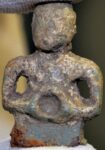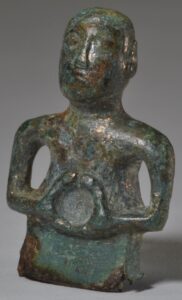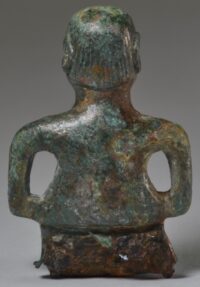A Celtic figurine discovered at the Wimpole Estate in Cambridgeshire is sporting a distinctive mullet, a possible indicator of hair styling fashion in Late Iron Age Britain. The 1st century A.D. copper alloy object is just two inches high and depicts a male figure holding a torc in his hands. He has oval eyes typical of Celtic design, a moustache and keeps his hair trimmed extra short in front, straight and long down his neck.
 The figurine was unearthed in July 2018 during the excavation of the Late Iron Age settlement at Lamp Hill. Volunteer metal detectorists scanned the excavation ditches and found the tiny mulletted man. The piece was at first believed to be a representation of the Celtic fertility god Cernunnos, but now that it has been cleaned and studied by specialists, it’s clear that he does not bear the attributes of Cernunnos. He may be a deity of unknown type with his Iron Age Billy Rae Cyrus look a distinguishing characteristic of a god with no other recorded likeness. He may also be a simple anthropomorphic figure whose hair reflects the tonsorial trends of his time.
The figurine was unearthed in July 2018 during the excavation of the Late Iron Age settlement at Lamp Hill. Volunteer metal detectorists scanned the excavation ditches and found the tiny mulletted man. The piece was at first believed to be a representation of the Celtic fertility god Cernunnos, but now that it has been cleaned and studied by specialists, it’s clear that he does not bear the attributes of Cernunnos. He may be a deity of unknown type with his Iron Age Billy Rae Cyrus look a distinguishing characteristic of a god with no other recorded likeness. He may also be a simple anthropomorphic figure whose hair reflects the tonsorial trends of his time.
It was not originally designed as a freestanding piece or cult figure. It was a decorative fitting, probably the handle of a spatula. The circular recess inside the torc probably held an inlay that is now lost.
Chris Thatcher from Oxford Archaeology East explained: “Finds such as this give a rare and fascinating insight into aesthetics and symbolism in the latest Iron Age. The extent to which his hairstyle is typical of contemporary styles will never be known for certain. However, we think the combination of him holding a torc – associated with status – and forming the handle of a spatula – either used to mix medicines, or wax for writing tablets – speak of influence and power. The fact that he was found on a site with so much other evidence for it being a local hub is wonderful and appropriate.”


Of course, there is a circular recess in a torc, but why an inlay? Usually there is a neck wearing it.
The mullet is what you end up with, if hairdressers are not available, due to an epidemic, warfare or maybe sacrifice, and it is not an uncommon sight these days, i.e. if not worn underneath a helmet. Striking is that he is not wearing the torc and, particularly, that he has no legs.
In context with the Estate, however, I read of marble busts on wooden plinths, so maybe there was a wooden socket or stake involved here that simply rotted away, or maybe they did not have enough copper alloy for his legs. Maybe, the torso was fitted onto a vehicle or a consecrated chariot.
Surely, there is a lake and a grove at the Wimpole Estate 😉
Tacitus, for example, reports in his ‘Germania’ in chapter 40:
——
…nemus, dicatumque in eo vehiculum, veste contectum; attingere uni sacerdoti concessum. […] Non bella ineunt, non arma sumunt; clausum omne ferrum; pax et quies tunc tantum nota, tunc tantum amata, donec idem sacerdos satiatam conversatione mortalium deam templo reddat. Mox vehiculum et vestes et, si credere velis, numen ipsum secreto lacu abluitur…
——
Dogmatic has a good point. I am sporting a pandemic mullet myself after 60 years of buzz cuts. Although mine is not quite so well groomed as Wimpole’s copper-man.